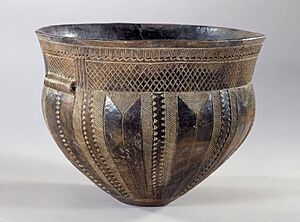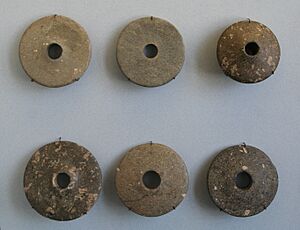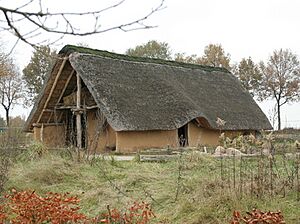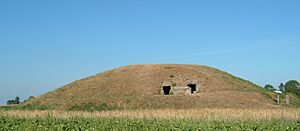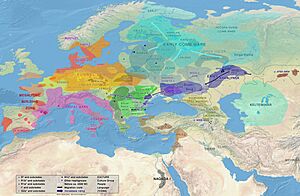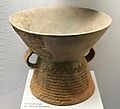Funnelbeaker culture facts for kids
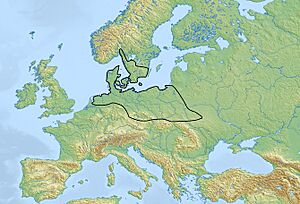 |
|
| Geographical range | Europe |
|---|---|
| Period | Neolithic, Chalcolithic |
| Dates | c. 4300 BCE – 2800 BCE |
| Preceded by |
|
| Followed by |
|
The Funnelbeaker culture, also called TRB, was an important group of people who lived in north-central Europe a very long time ago. This was during the Neolithic (New Stone Age) and Chalcolithic (Copper Age) periods, from about 4300 BCE to 2800 BCE.
This culture started when different groups of people in the area, who were already using pottery, began to combine their ways of life. Some were farmers, and some were hunter-gatherers. The Funnelbeaker culture brought farming and raising animals as main food sources to the northern areas where people mostly hunted and gathered.
The Funnelbeaker culture spread across a large area. It had different groups: a northern group in modern-day northern Germany and southern Scandinavia; a western group in the Netherlands; an eastern group around the Vistula river in Poland; and south-central groups around the Elbe and Saale rivers.
Later, around 3700 BCE, another culture called the Globular Amphora culture took over much of the eastern and southern Funnelbeaker areas. The Funnelbeaker culture then mostly remained in northern Germany and southern Scandinavia. Around 2800 BCE, the Single Grave culture replaced the Funnelbeaker culture in these areas.
Many of the large stone monuments called megaliths in north-central Europe were built during the time of the Funnelbeaker culture.
Contents
What's in a Name?
The Funnelbeaker culture gets its name from the special pottery they made. They created pots and jars that had a unique funnel-shaped top. These pots were often found in their burial sites.
A Look at Their History
The Funnelbeaker culture first appeared in northern Germany around 4100 BCE. It seems that people from the Michelsberg culture in Central Europe moved north and started this new culture. These Michelsberg people were likely farmers who had moved into Central Europe from places like Iberia (modern-day Spain and Portugal) and France.
Once established, the Funnelbeaker culture quickly spread into southern Scandinavia and Poland. This was a well-organized move, almost like a planned settlement. In southern Scandinavia, they replaced the Ertebølle culture, which had continued to live as hunter-gatherers for a long time, even after farming began in other parts of Europe.
People of the Funnelbeaker culture were mostly farmers, but they also mixed with local hunter-gatherer groups. This means they had some ancestry from both farmers and hunter-gatherers. In some areas, especially Scandinavia, up to half of their ancestry came from hunter-gatherers. This shows that the hunter-gatherers became part of the Funnelbeaker society.
Later, the Funnelbeaker culture expanded south again from Scandinavia into Central Europe. This expansion also involved many people moving. It seems that the Funnelbeaker communities in Central Europe became a mix of different groups.
Around the middle of the 4th millennium BCE, the Funnelbeaker culture started to decline. It was slowly replaced by the Globular Amphora culture in its southeastern areas.
In the early 3rd millennium BCE, the Corded Ware culture appeared in Northern Europe. These new people had different origins, coming from areas further east. During this time, the Funnelbeaker people built many defensive walls and ditches. This might mean there were conflicts between the Funnelbeakers, the Corded Ware people, and other groups. By 2650 BCE, the Corded Ware culture had replaced the Funnelbeaker culture.
Even though the Corded Ware culture took over, genetic studies show that Funnelbeaker women sometimes joined the Corded Ware communities. Also, the Corded Ware people continued to use the Funnelbeaker megalithic tombs for burials. Later cultures in Central Europe also show strong family ties to the Funnelbeaker people through their mothers' side.
Where They Lived
The Funnelbeaker culture stretched from the Elbe river in Germany and Bohemia (part of the Czech Republic) all the way to the Netherlands in the west. In the north, it reached southern Scandinavia (including Denmark, parts of Sweden, and Norway). To the east, it extended to the Vistula river in Poland and parts of Ukraine.
How They Lived
Homes and Villages
Most Funnelbeaker settlements were near the coast, similar to the earlier Ertebølle culture. However, some were found inland. They lived in single-family houses, usually about 12 meters long and 6 meters wide. These houses were built using a technique called wattle and daub, where woven branches are covered with mud or clay.
Their Economy
The Funnelbeaker people mainly raised animals like sheep, cattle, pigs, and goats. But they also hunted and fished to get food. They grew simple crops like wheat and barley in small fields. These fields would quickly lose their richness, so the people often moved short distances to find new land for farming.
They also mined for flintstone in areas like Malmö and the Świętokrzyskie Mountains. Flint was a very important stone for making tools. They traded this flint with regions that didn't have it, such as the inland areas of Scandinavia. The Funnelbeaker culture also used copper from Silesia (a region in Poland and Germany) to make tools like daggers and axes.
Their Technology
The Funnelbeaker culture has the oldest evidence of wheeled vehicles in Central Europe. One amazing example is an engraving on a ceramic pot found in Bronocice, Poland. This image, from around 3636 to 3373 BCE, shows what looks like a covered wagon. It's the oldest picture of a wheeled vehicle in Central Europe! The wagon was likely pulled by oxen, as their bones were found near the pot. Today, you can see this pot in the Archaeological Museum of Cracow.
Even older evidence of wheeled vehicles was found at Flintbek in northern Germany. Cart tracks dating back to about 3400 BCE were discovered under a large burial mound. This is the earliest direct proof of wheeled vehicles anywhere in the world, not just models or pictures.
-
The Bronocice pot, Poland, around 3500-3350 BCE.
Graves and Burials
The Funnelbeaker people often built their homes near large, impressive graves. These graves were important symbols of their community. Their burial customs changed over time and varied by region, but they usually buried their dead (called inhumation).
The oldest graves were wooden rooms inside long mounds of earth. Later, they built large stone tombs called passage graves and dolmens. These stone structures were probably covered with earth mounds, and their entrances were blocked by a stone.
The Funnelbeaker culture is known for the appearance of these huge stone tombs, or megaliths, along the coasts of the Baltic and North Seas. An example is the Sieben Steinhäuser in northern Germany. At these graves, people would leave offerings like ceramic pots filled with food, amber jewelry, and flint axes.
Their Beliefs
The Funnelbeaker people also placed flint axes and pots in streams and lakes near their farms. It's thought that almost all of the 10,000 flint axes found in Sweden from this culture were offerings left in water.
They also built large religious centers. These centers were surrounded by fences, earthworks, and ditches. The biggest one found is at Sarup on the island of Fyn in Denmark. It covers a huge area of 85,000 square meters! It's estimated that building it would have taken 8,000 workdays. Another large center was at Stävie in Sweden, covering 30,000 square meters.
Who Were They?
Some experts believe the Funnelbeaker culture did not speak an Indo-European language. They are seen as a culture that developed from earlier groups in Europe, before people speaking Indo-European languages arrived from the east (like the Yamna culture).
In the past, some archaeologists thought the Corded Ware culture simply grew out of the Funnelbeaker culture. However, genetic studies have shown that this wasn't the case. The Corded Ware people were different and came from other areas.
Genetics: What Their DNA Tells Us
Scientists have studied the DNA from the bones of Funnelbeaker people. These studies show that the Funnelbeaker culture was mostly made up of people who were "Early European Farmers" (EEF). These farmers had moved into Europe a long time ago.
However, the Funnelbeaker people also mixed with local hunter-gatherers. In Scandinavia, about half of their ancestry came from hunter-gatherers. In Central Europe, it was about 40%. This mixing shows that the Funnelbeaker culture grew by including the people who were already living in those areas.
Later, when the Corded Ware culture arrived from Eastern Europe, they also mixed with the Funnelbeaker people. The DNA shows that Corded Ware males often mixed with Funnelbeaker females. This means that even though the Funnelbeaker culture was replaced, their genetic legacy continued in later groups.
A recent study in 2024 confirmed that the Funnelbeaker people were mainly descended from early farmers from Anatolia (modern-day Turkey). They replaced the hunter-gatherers in the area without much mixing at first. This Funnelbeaker population lived for about 1,000 years until new groups with ancestry from the Steppe regions of Eastern Europe began to arrive.
See also
- Linear Pottery culture
- Salzmünde group
- Schönfeld culture
- Pit–Comb Ware culture
- Cardium Pottery culture
- Vlaardingen culture
- Prehistory and protohistory of Poland
- Stone Age Poland § Neolithic
- Scandinavian prehistory
- Prehistoric Germany
- Prehistoric Europe
- Old Europe
- Neolithic Europe
- Invention of the wheel
Images for kids


